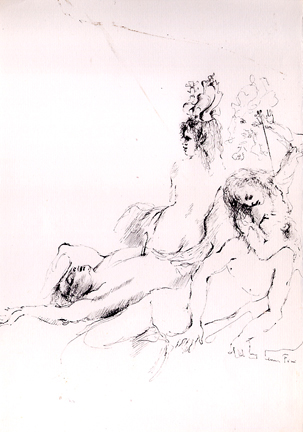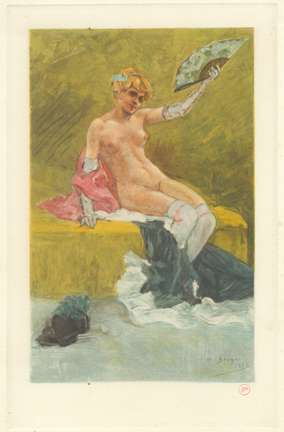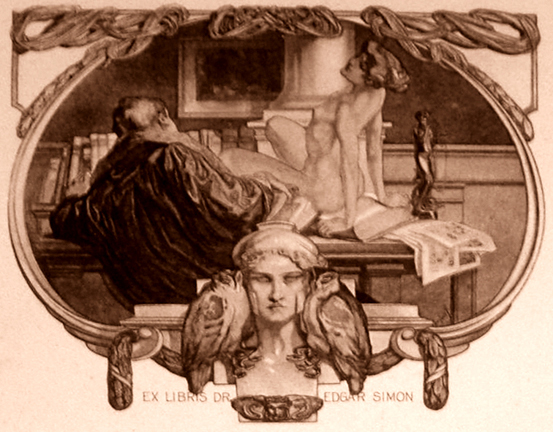|
CFM Gallery |
Chelsea's Most Exciting Figurative Art Gallery 236 West 27th Street, 4th Floor,
New York, NY 10001 |
Visit
the Gallery |
| The term “erotic,” when applied
to art, generally infers an aesthetic ghetto of under-the-counter
materials to be ogled behind closed doors. Or else it is employed
as euphemistic Vaseline to lubricate the passage of art that might
be construed as “dirty” through the back door of High Culture.
Thus the word, which has come through overuse to seem as vulgarly
insinuating as one of Sarah Palin’s sly campaign winks, is underplayed
in the press release for “Liaisons: The Fine Art of Love, Lust
& Romance (1870-1970), on view at CFM Gallery, 112 Greene Street,
from October 9th through November 7th. Instead, a boldface blurb for
the show declares, “At CFM Gallery, in SoHo, yesterday’s
pornography is today’s Fine Art!” Neil Zukerman, the owner of CFM and curator of the exhibition is not a man to mince words. Nor is he a man to undermine sensuality, which runs unfettered throughout the Surrealist and Symbolist schools of art for which he has long been our most vociferous contemporary champion. And nowhere is this more evident than in the work of the four artists that he has chosen to feature in this exhibition: Leonor Fini (1907-1996), Salvador Dali (1904-1989), Felician Rops (1833-1898), and Franz von Bayros (1866-1924). Over the years Fini, the sole female artist in the group, has shocked some with the strong sapphic content in her paintings and prints, although it’s difficult to fathom how any person of sensibility could fail to appreciate her nubile vixens, since they are so much more fetching than the pubescent frumps upon whom the jaded voyeur Balthus fastens his leering male gaze. And if Fini depicts their wicked little games and ardent schoolgirl caresses with such exquisite empathy that the viewer, too, is titillated –– well, isn’t art supposed to make one feel? |
 Leonor Fini |
No artist ever celebrated the female body with more unabashed passion than Fini, who is presently being honored with a major museum retrospective in Trieste, France, the city of her childhood. And her lissome figures are never more poignant than when they are being subjected to sadomasochistic sexual initiations by tumescent males, as seen in the two selections of her work featured most prominently in this exhibition.
Taken together, what Fini’s illustrations for the Marquis de Sade’s
“Juliette” and Pauline Réage’s “Histoire d’O”
(“The Story of O”) demonstrate so beautifully is her ability
to tailor her visual interpretation of the text to the mood of each particular
book without sacrificing the integrity of her distinctive style. Thus
for “Juliette” (which Neil Zukerman delights in pointing out
“was actually printed on the presses of the Vatican!”) she chose
a delicate, one might even say “lacy,” linear manner which complements
auspiciously the verbal filigree of de Sade’s ornate prose. And if
the vilest perversions are made palatable by the elegance of the Marquis’
writing, Fini’s transcendent illustrations elevate the hellish to
the level of the heavenly.
 Felecien Rops |
By contrast, for “Histoire d’O,”
Fini took a much starker approach, with a stabbing line drawn over
dark wet-into-wet washes that spread the ink over the paper like tendrils
or nerve-endings frayed by the multiple humiliations to which the
novel’s masochistic heroine willingly submits. Indeed, one gets
the sense that Fini’s own androgynous sensibility (she seems
to have relished girlishly beautiful boys almost as much as boyishly
beautiful girls) enabled her to inhabit each author’s psyche,
identifying in turn with sadist and masochist, tormentor and victim,
and making the pleasure and pain of each manifest in her drawings.
The only constant is that each end of the S&M spectrum is made
sublimely sensual in its own way, allowing the reader to experience
vicariously the shudder of sensation that attends such liaisons, as
foreign as they may seem to his or her own usual inclinations. As with Fini, to consign any aspect of Salvador Dali’s work to the category of so-called erotic art would seem redundant, if not simply silly, since sexuality in all its many guises is integral to his oeuvre. Despite his long marriage to Gala, Dali’s own sexuality remains shrouded in mystery. Among the gossipy denizens of Andy Warhol’s Factory, with whom he was known to fraternize when in New York City in the early 1970s, he was generally assumed to be voyeuristically bisexual, although there is no evidence of his ever having participated in any of the orgiastic activities that he liked to stage and watch, which would put his private life in harmony with his work as something mainly metaphysical. So one might be forgiven for assuming at a quick glance that the devilish looking bearded gent in Dali’s “Homme baisant la chaussure” is salivating on a large penis with a long, drooping foreskin, when it is in fact a fancifully distorted high heeled shoe (much like the ones Warhol drew for Bonwit’s during his early years as an illustrator) that he is licking. And in “Sphinx,” the pretty profile of the lissome male nude blowing a kiss to the winged creature with large female breasts and features almost identical to his own at very least suggests a fascination with androgyny. |
Yet, the clearly female nude in Dali’s “nu
aux deux nombries,” although evoked with just a few spare, swift
strokes, is possessed of such unambiguous Playboy centerfold voluptuousness
that one can almost feel the palpable, slappable weight of her womanly
warmth. But while it’s always fun to speculate on the degree of subjective
delectation revealed in the nude figures of any artist, all bets are off
when it comes to the transcendent draftsman Dali!
The Belgian engraver, lithographer, and painter Felician Rops, on the
other hand, was an unequivocal admirer of the female form, unafraid to
reveal his gleeful lasciviousness in every line that he laid down on paper.
Yet let it never be said that Rops’ horniness overshadows his visual
wit or blunts the satirical edge that tempts one to call him a Daumier
of the boudoir.
One of the first prints by Rops that caught my eye many years ago was
one of a nun giving a nude novice an enema while another sister stood
by holding the irrigator as though it were a crucifix. This made quite
an impression on a lapsed Catholic youth, putting one in awe of Rops’
anticlerical irreverence, particularly since he lived in a time when the
Church still had the political clout to set the hounds of civic hell on
his heels.
Over the years, Neil Zukerman has amassed the largest collection of Rops’ works outside of the artist’s native Belgium, many rarely, if ever, exhibited in New York. One of the most spectacular pictures culled from that collection and featured in this exhibition is a color print of a satanic crucified satyr hanging from the cross with an enormous erection and his hairy animal legs wrapped around the shoulders of a magnificent standing female nude. Instead of cloven hooves he has an extra pair of hands with which he appears to be strangling the woman with her own long raven locks as she nestles her head on the pillow of his bulging scrotum and stretches out her arms in mortal ecstasy, as though she too writhes on a cross.
 Franz von Bayros |
By contrast, a much smaller print of a nude woman straddling
a seated satyr, while nowhere near as open to charges of blasphemy, must
also have caused quite a stir in Rops’ day, since she is clearly
the aggressor, ravishing him, rather than coyly fleeing the rapacious
man-beast in the classic manner.
Then again, one would not be surprised to learn that Felician Rops had
created a scandal with even his least explicit print in the exhibition.
It shows a sweetly smiling girl with a blue ribbon in her blonde hair,
leaning back on a bed wearing nothing but white elbow gloves and white
stockings, as she playfully waves an ornate Oriental fan in the air. In
fact, it is a picture so ostensibly innocent that it might have made a
lovely calendar decoration. Yet the girl is so young, so very pretty,
and so clearly, wholesomely unembarrassed by the physical bounty that
nature has bestowed upon her as to give grave offense to any life-denying
bluenose.
|
“Step-children of joyous living, with no feeling
for beauty,” the Austrian illustrator and painter Franz von
Bayros would later call such people.
|
 Salvador Dali |
But it was gratifying to read, in an account of the trial by Rudolf Brettschneider,
that “on this occasion he was gloriously acquitted and received the
tumultuous applause of his friends.”
And once again the peculiar genius of Franz von Bayros is vindicated this
time for the contemporary viewer in this courageous and exciting exhibition
at CFM Gallery. Indeed, anyone who finds nothing to enjoy in “Liaisons”
would be well advised to have his or her pulse taken.
–– Ed McCormack,
Gallery
& Studio Magazine.
September-October 2009
|
Exquisite
technique coupled with artistic vision defines our user-friendly
presentation of figurative fine art paintings, sculptures and original
graphics. Contemporary symbolism at its apex in the traditions of
Bosch, the Italian Renaissance, Art Deco, Art Nouveau, the Viennese
and German Secession and the symbolist movements with an edge of
surrealism.
|




















